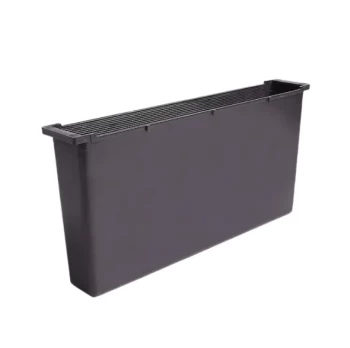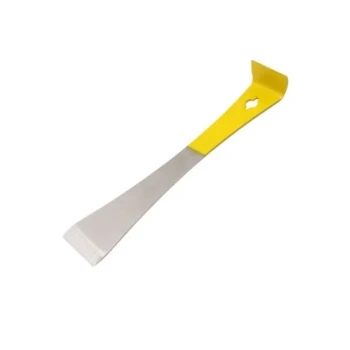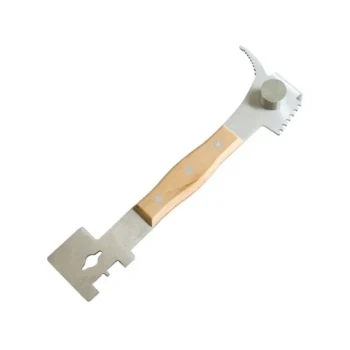To prepare a standard bee syrup, you should mix a 1:1 ratio of regular table sugar and water. Heat the water to near-boiling, remove it from the heat source, and then stir in the sugar until it is completely dissolved. It is critical that you do not boil the sugar mixture and that you allow it to cool completely to room temperature before giving it to your bees.
The recipe for bee syrup is simple, but the strategy is not. The ratio of sugar to water you choose—either a light 1:1 syrup or a heavy 2:1 syrup—is a powerful tool that directly influences your colony's behavior, from spring growth to winter survival.
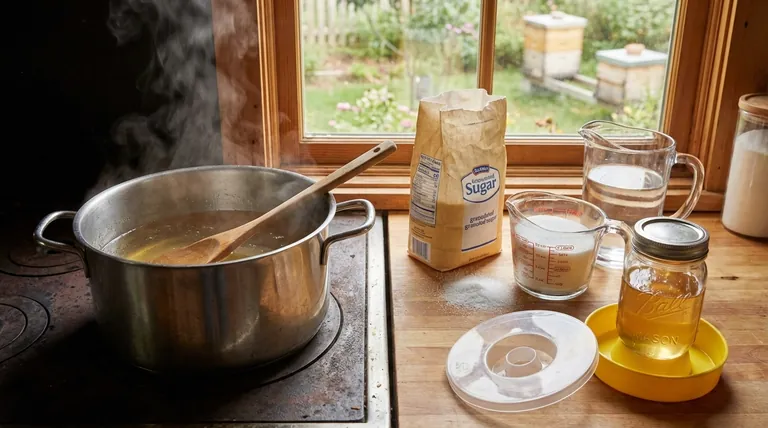
Understanding the Two Essential Syrup Ratios
The primary reason to feed bees is to supplement their natural forage when it is insufficient. The type of syrup you provide signals different environmental conditions to the hive.
The 1:1 "Spring" Syrup: For Stimulation
A 1:1 ratio of sugar to water (by either weight or volume) creates a light syrup that closely mimics the consistency of natural nectar.
This tells the colony that a nectar flow is on. It is used to stimulate the queen to lay more eggs and to encourage the worker bees to draw out new comb on foundation. This is the standard choice for spring buildup.
The 2:1 "Fall" Syrup: For Winter Stores
A 2:1 ratio of sugar to water creates a heavy, dense syrup. This is a much more concentrated energy source and does not resemble a light nectar flow.
This syrup is used as a direct food supplement when honey stores are low or when you need to help the bees build up their food reserves in preparation for winter. It requires less work for the bees to process and store.
The Correct and Safe Preparation Method
The process is straightforward, but precision is key to ensuring the syrup is beneficial and not harmful.
Step 1: Heat the Water
Begin by heating the required amount of water in a pot. Bring it to a gentle boil or a near-boil, then immediately remove it from the heat source.
Step 2: Dissolve the Sugar
Pour the measured amount of table sugar into the hot water. Stir the mixture continuously until all sugar crystals have completely dissolved. The final liquid should be clear, not cloudy.
Step 3: Cool Completely
The syrup must be cooled to room temperature before it is given to the bees. Feeding hot syrup can injure or kill them.
Critical Pitfalls to Avoid
Simple mistakes in preparation or feeding can have severe consequences for your colony.
Never Boil the Syrup Mixture
While you heat the water, you must not boil the sugar and water together. Boiling sugar syrup can increase the levels of a compound called Hydroxymethylfurfural (HMF), which is toxic to bees.
Prevent Drowning in Feeders
Open feeders, like frame feeders or top feeders, can present a drowning risk. If you use them, ensure they have built-in ladders or add floats (like wood chips or corks) to give the bees a safe place to land.
Choose the Right Feeder Type
Feeders come in several styles. Mason jars with small holes in the lid are popular for hobbyists and reduce drowning. Frame feeders go inside the hive, replacing a frame, and hold a large volume but require floats. Commercial beekeepers often use large bucket feeders.
Making the Right Choice for Your Goal
Your feeding strategy should align directly with what your colony needs at a specific time of year.
- If your primary focus is stimulating spring growth and comb building: Use a 1:1 syrup to mimic a natural nectar flow.
- If your primary focus is providing emergency food or building winter stores: Use a heavy 2:1 syrup for a dense and efficient food source.
- If your primary focus is hive safety in a small apiary: Use a closed system like a jar or bucket feeder to minimize drowning and prevent robbing from nearby hives.
Properly preparing and timing your syrup feedings is one of the most effective ways you can support a healthy and productive colony.
Summary Table:
| Syrup Ratio | Primary Use | Key Effect on Hive |
|---|---|---|
| 1:1 (Light) | Spring Stimulation | Mimics nectar flow; encourages brood rearing & comb building |
| 2:1 (Heavy) | Fall/Winter Stores | Provides dense energy for efficient food storage |
Ensure your apiary's success with the right supplies. Proper feeding is fundamental, and having reliable, high-volume equipment is key for commercial beekeepers and distributors. HONESTBEE supplies durable, wholesale-focused beekeeping supplies—from bulk sugar buckets to efficient hive-top feeders—designed to support the health of your colonies and the scalability of your operation.
Contact our experts today to discuss your wholesale needs and optimize your feeding strategy.
Visual Guide
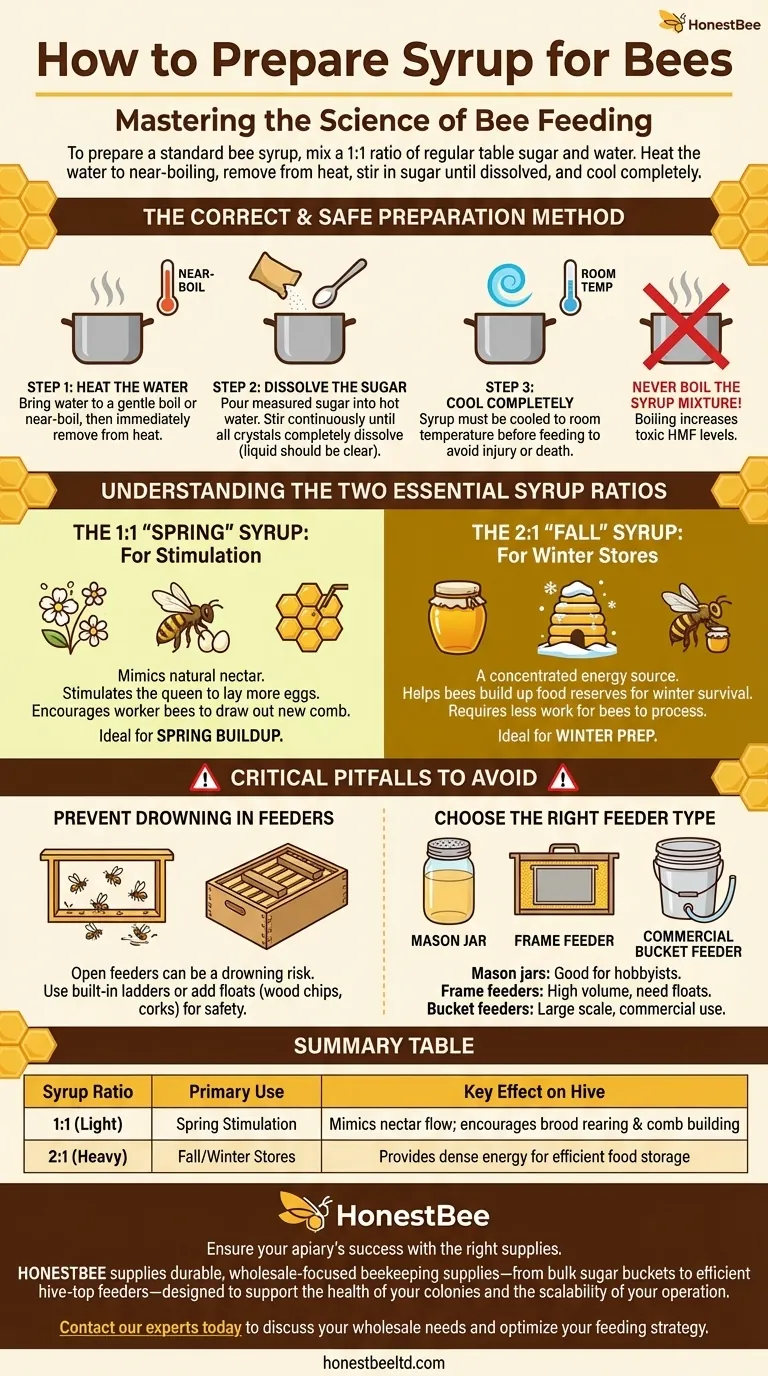
Related Products
- HONESTBEE Round Hive Top Bee Feeder for Syrup
- HONESTBEE Entrance Bee Feeder Professional Hive Nutrition Solution for Beekeeping
- Professional Hive Top Bee Feeder for Beekeeping
- Professional Hive Front Entrance Bee Feeder
- HONESTBEE Entrance Bee Feeder Efficient Hive Front Liquid Feeding Solution for Beekeeping
People Also Ask
- How do hive top feeders work? A Guide to Efficient, High-Capacity Bee Feeding
- What is the correct method for preparing sugar syrup for bees? Ensure Safe, Non-Toxic Feeding for Your Hives
- What features make top feeders a reliable choice for beekeepers? A Guide to Safe, Efficient Hive Nutrition
- How do you set up and use a top feeder for bees? A Step-by-Step Guide for Safe Feeding
- What are the features of top feeders for bees? Maximize Hive Health with Safe, High-Capacity Feeding











